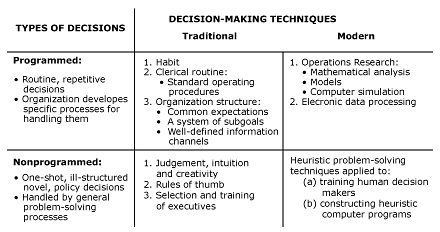
- Wednesday, June 15th, 2016
- programmed or nonprogrammed
-
I came across a handout from an information systems class that I took more than forty years ago. The front page had a grid that was based upon the work of Nobel laureate Herbert Simon from 1960. Here it is:

As I looked at it, I started to think about investment decision making. Using this grid, are investment decisions programmed or nonprogrammed? Are they more often “routine and repetitive” or “one-shot, ill-structured, and novel”? There are different camps of belief. For example, someone who believes in indexation has chosen to own “the market” today, tomorrow, and forever. That’s as straightforward and programmed as it gets.
But the categorization as presented primarily made me ponder the boundaries of quantitative investment management (programmed) versus fundamental management (nonprogrammed). Quantitative approaches have been around a long time — thirty years ago there were simple versions of much of what is popular today — but the complexity of the strategies and the frequency with which they are traded have expanded in step with the giant leaps in computing power. Quantitative investing is not a monolithic category, of course; high-frequency trading algorithms operate differently than “smart beta” ETFsThe Prudent Fiduciary Digest | The last issue of my newsletter for institutional asset owners had a section on smart beta strategies. (Sign up for future editions if it looks interesting to you.) or mutual funds that use tilts of one sort or another to try to generate an index-plus return.
What they have in common is that programmed nature. The code can be and is changed over time, but at a given point, decisions are made according to the current rules in force, with no human intervention (barring a problem with execution that requires it).
On the other side of the fence are those investment activities that are the result of human decision making. The diagram above focuses on the importance of “judgement, intuition, and creativity” in such nonprogrammed work, but points out the prevalence of “rules of thumb” in traditional decision making and anticipates the use of “heuristic computer programs” that can help in the process. But the essence of it all is a person or group of people looking at the elements of a situation and deciding how to proceed.
Now put yourself in the position of an allocator or asset owner evaluating investment choices in each of the two categories. How would your analytical approach differ from one to another?
Unfortunately, the primary driver of manager selection is usually performance,the research puzzle | That was the topic of this recent posting. and it’s as comforting to slice and dice the numbers in various time frames for quantitative strategies as it is for fundamental ones, even if much of it is empty manipulation. How about beyond that?
Let’s take the obsessive use of the words “consistent and repeatable” as the highest praise that supposedly can be given to a fundamental investment process. I’ve railed about this before,the research puzzle | For example, this 2013 posting with that phrase as its title. but it’s worth revisiting.
What is it that is (or even should be) consistent and repeatable? Which aspects of the process should be viewed as immutable when you’re dealing with unique situations all the time — changing economies, markets, companies, and investors? Under scrutiny most claims of such constancy don’t stand up, but, more importantly, why should we want them to? Doing so is pining for a degree of systemization that isn’t representative of the mandate that fundamental investors are given.
When it comes to quantitative strategies, many evaluators lack the background to vet them and, because of the black-box nature of most of them and asset manager concerns that a “secret sauce” could be pilfered, never get the opportunity anyway. So what does a sound due diligence effort then look like?
Let’s skip to some other aspects of this programmed versus nonprogrammed divide. For years, investment organizations that have both fundamental and quantitative professionals have been trying to get them to work together, in the hopes of creating a “best of both worlds” strategy that combines human insight with computerized discipline. Most of those efforts seem to fail, usually because fundamental investors chafe at the limits that are imposed.
It’s good to ask ourselves which decisions should be made in a programmed way and which should not, so that we have the computers doing what they do best and us doing what we do best. That’s a combination that another Nobel winner, Daniel Kahneman, finds attractive.Knowledge @ Wharton | This is an article about Kahneman’s talk at an aptly named “people analytics” conference. “Algorithms are noise-free. People are not,” he has said. In what ways and at what times do we need each for optimal decision making?
That leads to another (huge) set of topics: How will investment organizations be designed in the future given the promise of more sophisticated computerized heuristics and, possibly, capabilities that cross over the line into artificial intelligence? What of the legions of investment professionals currently at work? What will their jobs look like a decade from now? How many will disappear?
It feels as if we are on the cusp of real change, with profound implications to come for investment organizations and investment professionals. No less than a thorough rethinking is required, but it all starts with deciding what should be programmed (and why), what should be left nonprogrammed, and how the two approaches should fit together.
